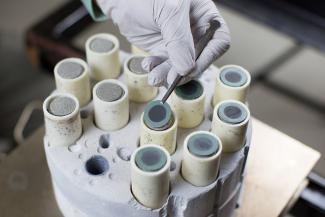Solid oxide fuel cells (SOFCs), a promising technology that can efficiently produce energy using fossil fuels with no moving parts and low emissions, present a particularly perplexing economic challenge: current systems operate at maximum efficiency between 700 and 1000 degrees Celsius, but such high temperatures shorten their service life, requiring more frequent fuel cell stack replacements. Lowering the operating temperature makes them last longer, but requires additional cells in the stack to deliver the same performance, and that drives up costs.
Researchers at the National Energy Technology Laboratory (NETL) are searching for answers to create SOFCs that can effectively operate at lower temperatures with a longer life-span by taking a deep look inside fuel cells on a microstructural level. It is a process that involves an integrated research effort across NETL, its research and industry partners, and their combined expertise in modeling, analysis, and characterization. Their work could lead to an effective and economical coal-based option for utility-scale power generation.
Fuel cells are electrochemical devices that rely on their components’ catalytic activity and conductivity to produce electricity. Changes happening in the microstructure can have big impacts on how well a cell performs. NETL modeling work is providing a detailed look at how SOFCs function over time under specific operating conditions and a better understanding of how these ultra-clean, ultra-efficient coal-to-electricity devices can be made more durable, economical, and commercially successful.
When investigating what factors could contribute most to improving the economics of SOFCs, and thereby enhance their commercial success, NETL systems analysis experts identified degradation as a key issue. Degradation is a continuous loss of performance over time. In SOFCs, degradation can manifest in different ways, but the end results are changes to the cell’s active regions (where reactions occur) and reduced longevity.
Currently, NETL’s SOFC program is mainly investigating two types of degradation: coarsening and interdiffusion.
Coarsening is related to a loss of surface area in the fuel cell. SOFCs operate at high temperatures. Over time, the particles comprising the SOFC electrodes grow together, or coarsen. As the materials coarsen, they lose surface area, which means the cell now has fewer regions where reactions can occur. This phenomenon is illustrated in the above graphic where the red and yellow cube represents the coarsening of materials over time and the purple regions represent the accompanying loss of reactivity.
Interdiffusion describes a change in composition at the interfaces between the different fuel cell components. This intermixing changes the SOFC composition and alters the activity and conductivity of the materials at that interface. As those properties change, so does the cell performance.
Investigating degradation requires a detailed picture of the SOFC microstructure, and getting a useful representation of the microstructure on the nanometer is an integrated research effort within the NETL SOFC group. NETL’s SOFC research draws on expertise resident in all three of its laboratory sites, Pittsburgh (PA), Morgantown (WV), and Albany (OR), as well as research collaborators at regional universities. The program involves modeling and sample analysis from the atomistic scale all the way up to full-scale commercial systems. Researchers experiment with SOFC samples from industrial partners and as technology is developed and matured, it is transferred to those partners for commercial use.
The SOFC program’s microstructural visualization work begins at Carnegie Mellon University, where NETL research partners use powerful microscopy equipment, such as focused-ion-beam scanning electron microscopes (FIB-SEM), to capture cross-section images of actual fuel cells from NETL industry partners. With this data, SOFC researchers produce high-resolution, three-dimensional reconstructions.
NETL has created the largest high-resolution electrode reconstructions in the world—some are 100 times larger than any other visualization efforts at the same resolution. Using these unique reconstructions, researchers examine the inner workings of the SOFC and quantify changes to an SOFC’s active regions over time. Modeling allows researchers to simlulate the SOFC aging process and obtain meaningful results faster and more economically than operating SOFCs for tens of thousands of hours.
Modeling also allows researchers to measure changes and study how specific parameters, such as surface area and particle size distributions, affect cell performance. Coupled with the information gained from 3D microstructure visualization, researchers can determine what operating conditions and microstructures will be most favorable for a given cell, leading to a longer, more productive cell lifespan.
While adjustment of operating conditions to prolong cell life is one approach, a second modeling effort at NETL examines SOFC properties to determine how the cell itself may be optimized for greater durability. In this effort, researchers use simulations of synthetic SOFCs to get a better idea of what constitutes the perfect fuel cell. Simulations offer the advantage of being faster and more precise than making physical lab samples. With simulations, NETL researchers design and test various theoretical microstructure configurations and materials that could not be readily constructed and tested without considerable other engineering efforts. They then draw conclusions about which aspects of a cell to target to boost performance and lifetime.
NETL’s SOFC systems analysis work guides the Lab’s R&D goals, and SOFC individual cell modeling work provides more focused guidance for the program’s engineering and fundamental science efforts. With a better understanding of how degradation occurs and the factors influencing an SOFC’s durability, researchers can engineer approaches and tools for minimizing degradation for specific conditions. This means more durable SOFCs that will last longer and function better to become an attractive coal-based option for utility-scale power generation.




